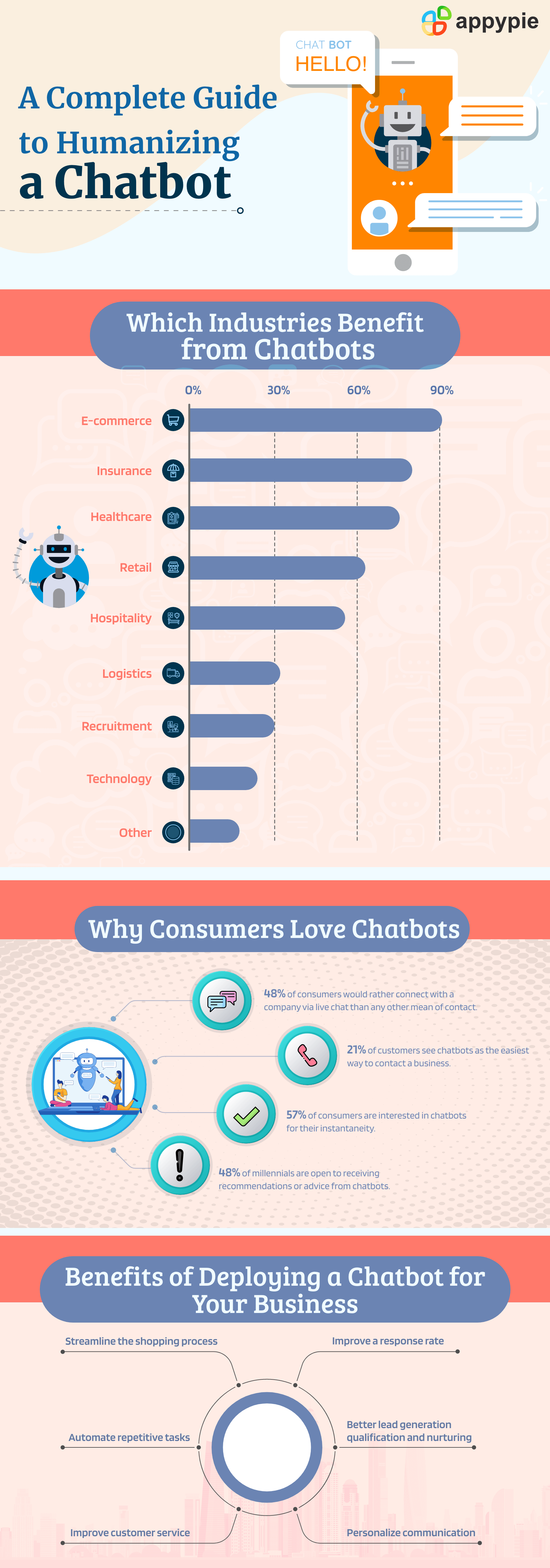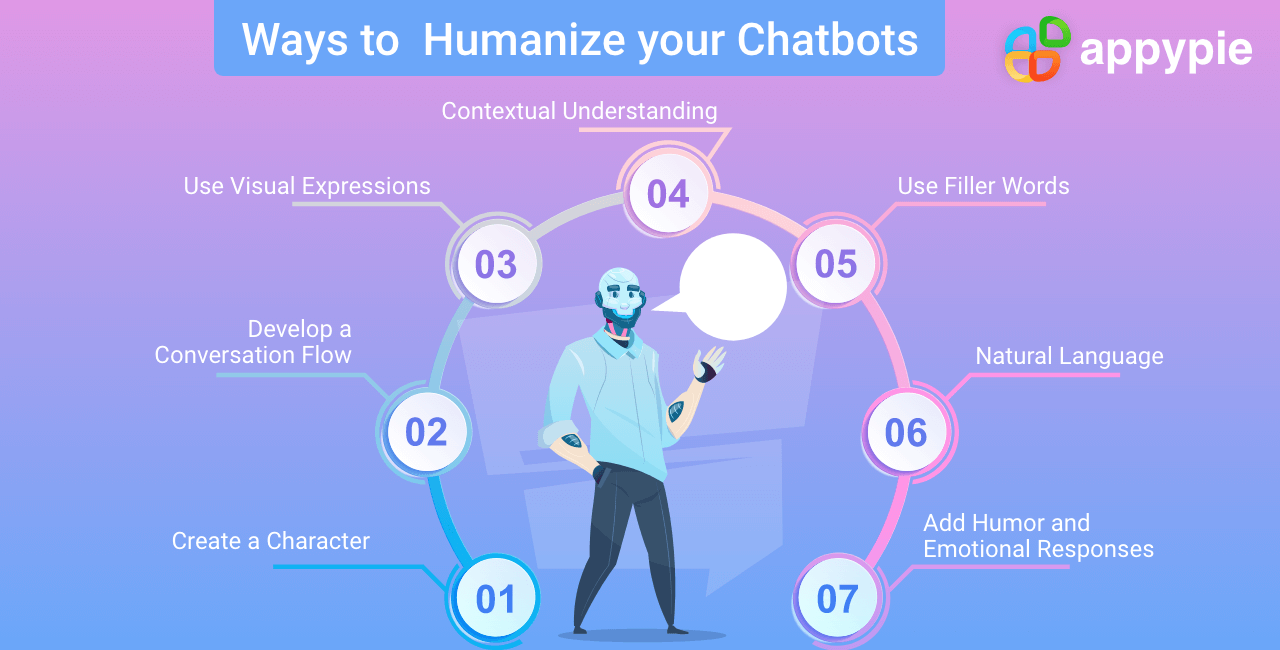7 Effective Tips to Humanize your Chatbot

By Neeraj Shukla | Last Updated on March 9th, 2024 12:24 pm | 4-min read
Table of Content
Many businesses nowadays have chosen to invest in conversational and personalized chatbots to replace human agents. Why wouldn’t they? Chatbots can conduct product purchasing, perform customer service solutions, recommend products and services, act like shopping assistants, and much more.
Chatbots created using help businesses improve their user experience by solving problems using conversational AI and reducing human assistance. They help you create a positive brand image and ensure that your customers are happy. Chatbots are critical for businesses to connect with the customers and have them feel listened to, understood, connected, and accommodated.
 To make sure your chatbots provide your users with natural two-way communication, you need to humanize them. In this post, we have listed a few ideas to help you add more human-like qualities to your chatbots and make them sound real.
To make sure your chatbots provide your users with natural two-way communication, you need to humanize them. In this post, we have listed a few ideas to help you add more human-like qualities to your chatbots and make them sound real.Ways to Humanize your Chatbots
Chatbots are one of the best tools to serve your customers as they include features like full-time availability, clear conversation flow, excellent customer handling capacity, and much more. However, they must act like a human to deliver a delightful customer service experience. Here are a few major ideas that can help you humanize your chatbots.- Create a Character
- Develop a Conversation Flow
- Use Visual Expressions
- Contextual Understanding
- Use Filler Words
- Natural Language
- Add Humor and Emotional Responses
You must create a character that represents your brand to the customers. It helps them recognize your business from anywhere and makes them comfortable in buying your products. When you give a name and personality to your chatbot, you eradicate the cold connection that users experience when the responses sound robotic and computerized.
Live chats featured with characters, names, and personalities help customers feel connected to your brand and humanize their overall experience of interacting with you. To get this done, you need to map your brand identity, make sure it matches your brand image so that users can differentiate you from your competitors.
A chatbot named ‘Mike’ looks more welcoming than a chatbot named ‘Bot’. The name makes the chatbot sound like a real person and helps users to get familiar and trust it to fix all their issues.
You can keep your customers engaged and attracted with the help of conversational marketing. Personalized responses, two-way conversations, instant solutions help businesses create a value-driven and powerful chatbot conversation strategy.
Develop the conversation flow first to constitute all the possible scenarios that the chatbot could meet with. You need to develop this flow keeping in mind the kind of experience that you want to deliver to your customers.
You can work on your script once the conversation flow is ready. Try to keep it short and simple to avoid devastating the user with the lengthy blocks of text.
Sometimes words are not just enough, and you need to use visual expressions to express yourself. You can do the same with the chatbots too. You can add images, GIF’s, emojis, and videos to chatbot database. You can program your chatbots for using different kinds of media to convey their message to the customers.
Doing this can help your chatbots connect with the users so that they can trust it. You just need to program your bot to the advantage that your users could believe that you are a credible business that they can depend on.
Once you incorporate rich content strategy, your communication with the users becomes crystal clear. However, overdoing this can get annoying and rout the purpose.
Context plays a critical role even in our everyday conversations and the same should be reflected in chatbot conversations. Chatbots need to have a contextual understanding to know what exactly the users are looking for.
For example, if a user doesn’t remember your product name and tries to explain it with the features it has or how it looks like, your chatbot should be able to understand that. It will not work if your chatbot will only be designed to identify keywords.
To avoid such miscommunication, you must develop your chatbot and incorporate context to make sure that it detects user intent. This feature makes the conversation helpful, engaging, and relevant.
Program your chatbots to use filler words to sound real. Filler words help bots to fill in the silence and to collect the required information. They help chatbots further humanize the user experience and to make them comfortable doing business with you.
Latency in responses, on the other hand, also helps bots in making the conversation real. You can program your boys with typing indicators. You don’t expect a response from somebody the moment you pressed the send button. To sound human-like and more natural, chatbots should sometimes lag between responses.
Your chatbot should feel realistic while communicating with new or existing users. However, being too formal can sound impersonal. If you are representing your chatbot as human alike, it should act and speak like one. Users always try to relate to whoever they are interacting with if they feel comfortable enough to believe that they will be helped. Try to create a casual and informal interface for your chatbot and program it to address the users by name to make them feel like they are talking to someone they already know.
Natural language processing also helps computers derive, interpret, and understand the natural human language. It helps bridge the gap between computer and human communication.
Implementing natural language processing can humanize your chatbot and improve its performance. It not only helps chatbots identify keywords but also enables them to find out the intent of the message they’re preparing a response for.
You always need to think subjectively while you add humor to your chatbot programming as something that can be hilarious to one customer can be invasive to another.
You must know how to play around with this element. It surely adds to your chatbot’s personality and enables it to establish good relationships with your customers. Your chatbot should be well-programmed to maintain a balance between using humor suitably in line with the sentiment of the users and not have it annoy them.
The best time to use this element in the chat is when you are trying to break the ice and grab the user’s attention to get them re-engaged. Other than that, you can use humor to cover up a mistake to ease the matter and lighten the situation. Conclusion
Humanizing a chatbot helps businesses establish an emotional connection between a bot and their customers and brings tremendous benefits for business. Always remember chatbots are machines but they don’t need to sound like one. To know more benefits of chatbots, click here. You can create a well-programmed and a more human-like chatbot for your business by using Appy Pie’s amazing no-code Chatbot Builder. These chatbots help you deliver your users with personalized and delightful user experience. With Appy Pie’s Chatbot Builder you can customize your chats as per the user preferences. Appy Pie’s Chatbots help you serve your customers with full-time availability and location flexibility. Try Appy Pie today!Citations
Ways to Humanize your Chatbots – Learn.g2.com Inc.comRelated Articles
- How CHATBOTS Can Help You Improve SALES & CUSTOMER SERVICE?
- A Beginner’s Guide to Chatbot Marketing [Benefits and Tips]
- How to Make a Chatbot From Scratch?
- Chatbot: History, Technology, Evolution, and Applications
- How to Build Chatbots with Conversational AI?
- How to Build a Lead Generation Chatbot?
- Chatbot Applications: How are Top Industries Using Chatbots?
- How to Improve User Bot Engagement for Business Growth?
- 7 Effective Tips to Humanize your Chatbot
- How to Create a Career Counselling Chatbot? (Step-by-Step Guide)
- Inbound vs. Outbound Call Centers: Definition, Types, and How They Work
- 10 Ways Conversational AI Is Improving the Customer Experience
- ChatGPT vs. Bing Chat: Which AI Chatbot is Right for You? [Top Integrations]
- IBM Watson Chatbot: How to Create a Similar Chatbot
